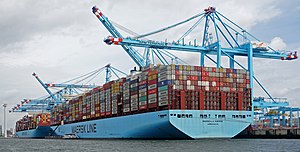
Back سفينة حاويات Arabic Buque portacontenedores AST Контейнеровоз Bulgarian কন্টেইনার জাহাজ Bengali/Bangla Portacontenidors Catalan Kontejnerová loď Czech Containerskib Danish Containerschiff German Κοντέινερ (πλοίο) Greek Kontenerŝipo Esperanto
This article may require cleanup to meet Wikipedia's quality standards. The specific problem is: The "Sources" section needs to match existing short citations under "References", or be moved to a "Further reading" section. See discussion. (June 2024) |
 Two Maersk Line container ships
| |
| Class overview | |
|---|---|
| Name | Container ship |
| Subclasses |
|
| Built | 1956–present |
| In service | 9,535 ships as of 2010[1] |
| General characteristics | |
| Propulsion | Typically diesel since 1990[2] |
| Speed | Typically 16–25 knots (30–46 km/h) (19-29 mph)[2] |
| Capacity | Up to 24,000 TEU |
| Notes | Reduced superstructure, containers stacked on deck, bulbous bow |
A container ship (also called boxship or spelled containership) is a cargo ship that carries all of its load in truck-size intermodal containers, in a technique called containerization. Container ships are a common means of commercial intermodal freight transport and now carry most seagoing non-bulk cargo.
Container ship capacity is measured in twenty-foot equivalent units (TEU). Typical loads are a mix of 20-foot (1-TEU) and 40-foot (2-TEU) ISO-standard containers, with the latter predominant.
Today, about 90% of non-bulk cargo worldwide is transported by container ships, the largest of which, from 2023 onward, can carry over 24,000 TEU.